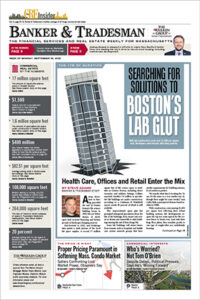Just call it the $21 billion Big Pig.
Five years after the cash-sucking tunnel and highway project formally concluded, we have little to show for the so-called Big Dig other than a short stretch of leaky tunnels underneath Boston and a second-rate, under-funded park above it.
And unlike most major transportation endeavors, the investment has failed to ignite even a modest development boom.
The Big Pig is a more apt name for a project that has come at the expense of just about everything else, sucking state coffers dry and threatening to leave the rest of Massachusetts with a Third World highway and rail system.
No Development Bonus
The cost of the Central Artery project can’t be understated – it’s roughly two-thirds of the entire state budget.
The project’s cost was pegged at $15 billion when it ended in 2007. The Boston Globe recently updated that figure to $21 billion, factoring in billions of dollars in interest. In fact, the price tag rises to roughly $24 billion when some mandated rail extension projects are included. When weighing the payback from this epic public investment, it’s worth keeping these staggering sums in mind.
Typically, if you spend a few hundred million dollars – let alone a few billion – on a highway project or a new rail line, you will spark a surge in new development, from retail stores to homes.
Developers build where the roads and rails lead – you wouldn’t have the western suburbs today if Route 128 had not been built back in the 50s.
The long-debated extension of the commuter rail system from Boston to New Bedford, for example, would generate $500 million a year in economic activity and create 3,500 new jobs, according to one state-commissioned study. It would also open up to residential development a corridor of sleepy towns ripe for new homes and apartments, at a time when housing prices are poised to take off.
And while the project’s $2 billion price tag is hardly chump change, it is peanuts compared to the kind of money that fed the Big Pig. But of course, the extension keeps getting put off, with the commonwealth struggling to pay for those gold-plated tunnels underneath the streets of Boston.
By contrast, the only major real estate spinoff from the Central Artery is the much touted and highly overrated Greenway, a collection of grassy patches that, while pleasant enough during the brief warm-weather months, are hardly going to win any design awards.
Developers have taken an interest in some of the sites next to the parks, but Boston officials insisted on all sorts of height restrictions sure to cool the ardor of the most aggressive real estate operators – just ask Don Chiofaro.
Meanwhile, years were frittered away as a series of overly ambitious nonprofits with grandiose plans for museums and cultural centers tied up key building sites while they tried, and failed, to raise any money.
Given the $21 billion spent on building the new underground highway beneath Boston, that’s not much of a payback.
Deferred Maintenance
The cash sucked up by the Big Pig looks even worse when you compare what half a billion dollars – roughly one fortieth of the project’s cost – might mean right now for the increasingly pathetic MBTA.
The state commuter rail and rapid transit authority only managed to balance its budget by jacking fares 23 percent, cutting back on service, and getting state lawmakers to pony up $159 million.
Still, there was a cheery story the other day about the T giving its employees classes on customer service. What a relief!
But the problem is not grumpy T employees, but chronically late, unreliable trains that have a bad habit of not showing up at all during a routine snow storm or other inclement weather. There are some problems that only money can solve – and trains that don’t work right or break down is one of them.
For that matter, all the money blown on the Big Pig has left Route 128, the center of our crucial tech economy and life sciences industry, in an increasingly precarious spot.
The highway is already well over capacity. From Burlington to Waltham, 128 is jammed with 200,000 cars and trucks per day, far beyond its rated capacity of 150,000, according to the Metropolitan Area Planning Council.
And those numbers are poised to go only skyward, after the former Polaroid campus in Waltham gets redeveloped and a host of other projects take shape.
There is no lack of potential long-term solutions for 128. But there is also no money to work with.
And still, 128 is just one literally dozens of bridges and highways that need work across the state. And many, at best, are likely to get only minimal fixes.
Yes, driving through downtown Boston or getting to Logan is a relative breeze compared to the old days. And the old Surface Artery was a big ugly.
But was it worth $21 billion?
I think not!






